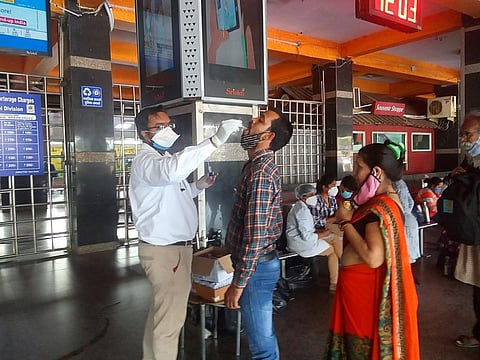Is India ready for the third COVID-19 wave?
The news of the forthcoming third wave of the novel coronavirus disease (COVID-19) has been doing the rounds for some time. The world is divided over several concerns.
Only 20 per cent of the Indian population is fully vaccinated against COVID-19, according tomost recent data by the Union health ministry. More than a year-and-a-half have passed since the pandemic hit us, but survival continues to be difficult. Whether we are ready for the third wave is what needs our collective attention now.
The number of COVID-19 cases reached its peak in September 2020, and started declining to 11,000 cases a day till February 2021. From February, cases reported a sharp rise.
There were several reasons behind this surge. Some health experts argued that emergence of the ‘double mutant’, the Delta variant, in India triggered an uptick.
The health infrastructure in India
As cases increased, the country faced an acute shortage of basic health facilities. The country needed approximately 0.6 million more doctors and two million more nurses in primary health centres (PHC) than what it had.
Human Development Report 2020 stated that India had 8.6 doctors and five beds for every 10,000 people; the doctor-to-population ratio was 1:1,163. The World Health Organization recommends the ratio should be 1:1,000.
In rural areas, the doctor-to-patient ratio is 1:10,926, which is an abysmal figure. The WHO recommends that India should have at least 44.5 health workers.
India has approximately 1.9 million hospital beds, according to the National Health Profile, 2019 and National Sample Survey, 2017-18. As many as 1,185,242 of these are private and 713,986 public; there are 95,000 ICU beds, of which 59,262 are private and 35,699 public. The country has 48,000 are ventilators: 29,631 are private and 17,850 public (number given for private is estimated from NSS data).
So, if we try to compute the total number of hospital beds per lakh population, it comes down to 138 (private: 86 and public: 52). Total ICU beds per lakh population are seven and total ventilators per lakh population are 3.5.
Data also suggests that the availability of public health care facilities in India is low in comparison to private, which affects a huge chunk of poor population.
There is also a large regional variation in the availability of resources among states such as Bihar, Assam, Jharkhand, Odisha and Gujarat. The states that perform better in terms of resource availability are also under pressure due to a higher caseload.
The first COVID-19 case was reported in January 2020; the Indian government had ample time to scale up investment in healthcare infrastructure, make-shift hospitals, hospital beds, ventilators and oxygen cylinders.
The Union government’s inability to control the pandemic resulted in widespread chaos and complete breakdown of the healthcare system in India, especially in northern states of Gujarat, UP, New Delhi and Bihar.
This pandemic-induced collapse of the healthcare system in India is the result of colossal neglect by successive governments. This is evident from the fact that the public healthcare expenditure in India is 1.26 per cent of the Gross Domestic Product.
There has been a meagre increase of 0.02 per cent in the health budget of the country in the last five years. Pandemic and the subsequent havoc is the manifestation of apathy shown by the governments towards the citizens of the country.
Views expressed are the authors’ own and don’t necessarily reflect those of Down To Earth


